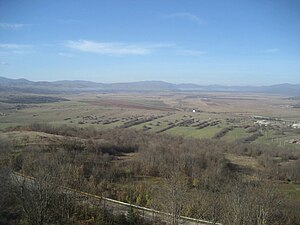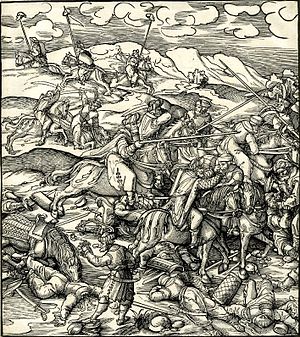Battle in the Krbava field
| date | September 9, 1493 |
|---|---|
| place | near Udbina in Lika , Croatia |
| output | Ottoman victory |
| Parties to the conflict | |
|---|---|
| Commander | |
|
Ban Emerik Derenčin |
Sanjak-beg Hadum-Jakub Pasha |
| Troop strength | |
| 3,000 horsemen, 5,000–7,000 foot soldiers |
8,000 riders |
| losses | |
|
about 7,000 men |
about 1,000 men |
In the battle on the Krbava field ( Croatian Bitka na Krbavskom Polju ) on September 9, 1493 Croatian and Ottoman troops faced each other in the Lika . Under the command of the Bosnian Sanjak - Beys Hadum-Jakub Pascha , the Ottomans defeated the Croatian feudal army under the command of the Croatian ban Emerik Derenčin . The Krbava field is located on the river of the same name near the city of Udbina .
prehistory
In the late summer of 1493 Hadum-Jakub Pascha crossed the rivers Una and Kupa with about 8,000 fighters (so-called akindžijam ) , invaded Styria and devastated the cities of Cilli and Pettau . On their retreat to Bosnia, the Turks devastated the Croatian Zagorje and pillaged the city of Modruš . According to the records of a Turkish historian, Hadum-Jakub Pascha met the Croatian army on a mountain range (probably on the Mala Kapela ), which blocked his way. Because Hadum-Jakub Pascha feared that troops from Styria would follow him, he wanted to buy the way back to Bosnia free and offered Ban Emerik Derenčin money. Derenčin, however, was convinced of the superiority of the Croatian troops and also assumed that the Turks might be exhausted by the withdrawal. He therefore demanded against the advice of the Croatian nobility the release of all those deported from Styria and Carniola and the surrender of the spoils of war. Hadum-Jakub Pascha refused. While the negotiations on the ransom of the prisoners were still ongoing, the pasha took advantage of the situation to get out of this predicament for himself and his armed forces and gave his troops the order to march across the Krbava field.
When Derenčin found out about the new route taken by the Turks, he gathered the Croatian nobles Ivan Frankopan Cetinski, Bernardin Frankopan Modruški, Nikola Frankopan Tržački, Karlo Gušić, Petar II. Zrinski, Ban von Jajce Juraj Vlatković and others, who had previously quarreled among themselves, with their troops the Krbava field. The Croatian armed forces consisted of 3,000 horsemen, 2,000 foot soldiers and 3,000 to 5,000 poorly armed and poorly armed peasants. It was decided to attack the Turks head-on in three meetings . The first group formed the Slavonian contingent under the command of Ferdinand Berislavić, the second group was led by Ivan Frankopan Cetinski and Ban Mihajlo Petkayo, the third by Nikola Frankopan Tržački with Bernardin Frankopan Modruški. The core of each corps was formed by the cavalry of the nobility, to which units of foot soldiers and peasants were added.
When Hadum-Jakub Pascha reached the Krbava field, he realized that the fight was inevitable and first had all men of the displaced civilian population capable of military service murdered. In order to avoid a frontal attack by the Croatians, he lured them to the flat Krbava field and then let them attack from all sides with his fast and agile cavalry. The Turkish riders were also divided into three groups, one section was led by Sandzak-Beg Ismail from Kruševac , the second by Karlerije Mehmed-Beg, governor in Skopje , and the third by Hadum-Jakub Pascha himself.
Course of the battle

The battle began in the early hours of September 9, 1493 with the attack of Turkish troops under Ismail Bey. Ban Emerik Derenčin came down with his Croatian force on the flat plain and attacked the Turks. After a short fight, Ismail Bey withdrew, the Croatians followed suit and got caught in the planned ambush. Mehmed Bey's troops attacked from the river Krbava. Shortly afterwards, Ismail Bey turned against the Croats again and Hadum Pascha attacked the Croatian armed forces head-on, which were now helplessly encircled. The early death of Juraj Vlatković and Ivan Frankopan Cetinski at the start of the fighting brought confusion to the ranks of Croatian soldiers. When Bernardin Frankopan von Modruš fled the battlefield, the Croatian resistance was broken. Ban Emerik Derčenin, Nikola Frankopan von Tržac and Karlo Gušić were captured.
The losses on the Croatian side were very high, even if the exact numbers are not known. What is certain, however, is that the Croatian aristocratic contingent was practically smashed on the Krbava field. Apart from the armed forces of the Bishop of Nin and the aristocratic families Zrinski and Frankopan , Croatia no longer had any troops and was now particularly dependent on the help of Inner Austria , because the Hungarian-Croatian King Vladislav II (Bohemia and Hungary) only had little to defend against the Turks could muster.
History recording by chroniclers
There are several historical records from both sides about the course of the battle on the Krbava field. The most frequently mentioned eyewitness accounts come from the hand of Bishop Juraj Divnić from the extinct Diocese of Nin , from the pastor Martinac, from the Venetian ambassador Antonio Fabreguese and from some Turkish chroniclers who are unfortunately not known by name .
The Bishop Juraj Divnić of Nin wrote to Pope Alexander VI. about the battle:
Holy Father, I think that Your Holiness has been informed of the tragic events of the lost battle of Christianity on the Krbava field, and thus also of the fall of the Croatian lands of Slavonia and Pannonia , caused by the enemies of our faith. I see it as my faithful endeavor that I too, saddened by tears, tell you with my letter how many of us had to endure the destruction. The battle from which the majority of those killed came from was fought within my diocese. And I followed all of this very sadly and also took part in it [...] (beginning of the bishop's writing)
He also describes the course of the battle:
On September 9, at six o'clock in the morning on the Krbava field under the town of Udbina, from where it doesn't take long to get to Dalmatia , the Ban Emerik Derenčin joyfully exclaimed: 'May the Lord be merciful to our plan'. At that moment the Turks were encircled and easily beaten. But ours did not recognize the ambush when the Turks unexpectedly split into three groups and surrounded ours and tried to turn the fight for themselves. The blood of ours froze in their veins. Many of our (foot soldiers) were trampled to death by the cavalry of both forces. The fight was now being waged face-to-face at close range. Nonetheless, ours were certain of victory and fought bravely, but fate would have it otherwise. On that one day in a confined space, 13,000 were captured or killed. There are tons of corpses on both sides, which the animals attack and there is no one to reverently bury them. Who should report on this disgrace? To the Turks this triumph did not seem enough, but so that they could show it, they cut off the noses of the dead in order to offer their master the proof. Ban Emerik Derenčin was captured and kidnapped, before they cut off his son's head in front of his eyes .
consequences
The most recent Croatian historical research has different views on the significance of the Krbava battle. Many Croatian historians regard the battle as a rather unimportant military event (even if, according to some historians, it means the decline of the tactical leading struggle of the feudal armies). In terms of historical significance for Croatia , the battle represents a radical change. The battle was the last attempt by the Croats to assert themselves against the Ottomans without the help of other great powers such as Hungary . After the lost battle on the Krbava field, the Croatian nobility no longer had the strength to defend themselves against the further advance of the Turks towards Europe. Several waves of Croatian emigration from the Lika area followed . This depopulation against the background of the constant threat from the Turks brought about a significant change in the population structure, with Wallachian , later Serbian and Ruthenian groups settling in the Turkish-controlled areas. The lost battle led to the disintegration of the Croatian lands. The previous unity was lost for centuries.
